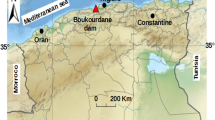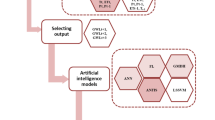Abstract
This study aimed to predict evaporation from dam reservoirs using artificial intelligence considering climate change. Mahabad Dam, near Lake Urmia, in northwestern Iran, is used to investigate the proposed approach. There are three parts to the study presented herein. In the first part, two machine learning models, namely group method of data handling (GMDH) and least squares support vector regression (LS-SVR), were used to model the inflow to the dam reservoir. Temperature, precipitation, and inflow during the previous month from 1990 to 2017 were used as input data. In the second part, the evaporation from the dam reservoir was modeled using the adaptive neuro-fuzzy inference system (ANFIS) and optimized ANFIS using Harris hawks optimization (HHO) and the arithmetic optimization algorithm (AOA) optimization algorithms. The input parameters in this part were temperature, precipitation, inflow to the dam reservoir, along with evaporation from the dam reservoir in the previous month. In the third part, precipitation and temperature were predicted using the fifth report of IPCC based on RCP2.6, RCP4.5, and RCP8.5 scenarios for the period 2020–2040. Out of 28 models presented in the fifth report, EC-ERATH and FIO-ESM had the greatest similarity with observational data of temperature and precipitation, respectively. The results of scatter plots and Taylor’s diagram showed the higher performance of LS-SVR (root mean square error (RMSE), mean absolute percentage error (MAPE), and Nash–Sutcliffe efficiency (NSE) of 8.65, 4.69, and 0.96) compared to GMDH (RMSE, MAPE, and NSE of 11.65, 7.81, and 0.93) in modeling the inflow. Moreover, both hybrid modes (AOA-ANFIS and HHO-ANFIS) improved the performance of ANFIS in modeling the evaporation from the dam reservoir. The RMSE, MAPE, and NSE values for ANFIS were 0.56, 0.52, and 0.89, respectively, while these values for the AOA-ANFIS (RMSE, MAPE, and NSE of 0.31, 0.24, and 0.93) and HHO-ANFIS (RMSE, MAPE, and NSE of 0.20, 0.30, and 0.96) were improved remarkably. The impact of climate change reduced the inflow to the dam reservoir by about 0.45, 0.80, and 1.7 MCM in RCP2.6, RCP4.5, and RCP8.5 scenarios, respectively. Also, the effect of climate change caused the evaporation from the dam reservoir to increase by about 0.2, 0.9, and 1 MCM in RCP2.6, RCP4.5, and RCP8.5 scenarios, respectively. The findings of this study show that the correct management of dam reservoirs needs to consider the potential effects of climate change in the future. Moreover, the hybrid machine learning models used in this study can be used to predict the amount of evaporation in other reservoirs.
















Similar content being viewed by others
Data Availability
Not applicable.
References
Abbaspour KC, Faramarzi M, Ghasemi SS, Yang H (2009) Assessing the impact of climate change on water resources in Iran. Water Resour Res 45(10).
Abreu ALE, Neto AC (2018) Machine learning model for predicting evaporation losses in reservoirs. IEEE Lat Am Trans 16(7):2040–2044
Abualigah L, Diabat A, Mirjalili S, Abd Elaziz M, Gandomi AH (2021) The arithmetic optimization algorithm. Comput Methods Appl Mech Eng 376:113609
Allawi MF, El-Shafie A (2016) Utilizing RBF-NN and ANFIS methods for multi-lead ahead prediction model of evaporation from reservoir. Water Resour Manage 30(13):4773–4788
Allawi MF, Binti Othman F, Afan HA, Ahmed AN, Hossain M, Fai CM, El-Shafie A (2019) Reservoir evaporation prediction modeling based on artificial intelligence methods. Water 11(6):1226
Allawi MF, Aidan IA, El-Shafie A (2021) Enhancing the performance of data-driven models for monthly reservoir evaporation prediction. Environ Sci Pollut Res 28(7):8281–8295
Althoff D, Dias SHB, Filgueiras R, Rodrigues LN (2020) ETo‐Brazil: a daily gridded reference evapotranspiration data set for Brazil (2000–2018). Water Resour Res 56(7):e2020WR027562
Arya Azar N, Ghordoyee Milan S, Kayhomayoon Z (2021a) Predicting monthly evaporation from dam reservoirs using LS-SVR and ANFIS optimized by Harris hawks optimization algorithm. Environ Monit Assess 193(11):1–14
Arya Azar N, Kardan N, Ghordoyee Milan S (2021b) Developing the artificial neural network–evolutionary algorithms hybrid models (ANN–EA) to predict the daily evaporation from dam reservoirs. Eng Comput 1–19
Asefpour Vakilian K, Massah J (2018) A fuzzy-based decision making software for enzymatic electrochemical nitrate biosensors. Chemom Intell Lab Syst 177:55–63
Ashofteh PS, Haddad OB, Mariño A, M. (2013) Climate change impact on reservoir performance indexes in agricultural water supply. J Irrig Drain Eng 139(2):85–97
Bac BH, Nguyen H, Thao NTT, Hanh VT, Duyen LT, Dung NT,..., Hiep NH (2021) Estimating heavy metals absorption efficiency in an aqueous solution using nanotube-type halloysite from weathered pegmatites and a novel Harris hawks optimization-based multiple layers perceptron neural network. Eng Comput 1–16
Chen W, Panahi M, Pourghasemi HR (2017) Performance evaluation of GIS-based new ensemble data mining techniques of adaptive neuro-fuzzy inference system (ANFIS) with genetic algorithm (GA), differential evolution (DE), and particle swarm optimization (PSO) for landslide spatial modelling. CATENA 157:310–324
Diaz-Nieto J, Wilby RL (2005) A comparison of statistical downscaling and climate change factor methods: impacts on low flows in the River Thames United Kingdom. Climatic Change 69(2):245–268
Emami F, Koch M (2019) Modeling the impact of climate change on water availability in the Zarrine River Basin and inflow to the Boukan Dam Iran. Climate 7(4):51
Ghorbani MA, Deo RC, Yaseen ZM, Kashani MH, Mohammadi B (2018) Pan evaporation prediction using a hybrid multilayer perceptron-firefly algorithm (MLP-FFA) model: case study in North Iran. Theoret Appl Climatol 133(3):1119–1131
Goodarzi E, Dastorani M, Talebi A (2015) Evaluation of the change-factor and LARS-WG methods of downscaling for simulation of climatic variables in the future (Case study: Herat Azam Watershed, Yazd-Iran). Ecopersia 3(1):833–846
Gupta PK, Yadav BK, Sharma D (2022) Impacts of climatic variability on subsurface water resources. In Advances in Remediation Techniques for Polluted Soils and Groundwater (pp. 171–189). Elsevier
Halik G, Anwar N, Santosa B (2015) Reservoir inflow prediction under GCM scenario downscaled by wavelet transform and support vector machine hybrid models. Adv Civil Eng 2015
Heidari AA, Mirjalili S, Faris H, Aljarah I, Mafarja M, Chen H (2019) Harris hawks optimization: algorithm and applications. Futur Gener Comput Syst 97:849–872
Hughes A, Mansour M, Ward R, Kieboom N, Allen S, Seccombe D, ..., Prudhomme C (2021) The impact of climate change on groundwater recharge: national-scale assessment for the British mainland. J Hydrol 598:126336
Hulme M, Jones PD (1994) Global climate change in the instrumental period. Environ Pollut 83(1–2):23–36
Jang JS (1993) ANFIS: adaptive-network-based fuzzy inference system. IEEE Trans Syst Man Cybern 23(3):665–685
Kayhomayoon Z, Azar NA, Milan SG, Moghaddam HK, Berndtsson R (2021) Novel approach for predicting groundwater storage loss using machine learning. J Environ Manage 296:113237
Kondo T (1998) GMDH neural network algorithm using the heuristic self-organization method and its application to the pattern identification problem. In Proceedings of the 37th SICE Annual Conference. International Session Papers (pp. 1143–1148). IEEE
Koukouli P, Georgiou PE, Karpouzos DK (2019) Evaluation of climate change impacts on reference evapotranspiration under RCPs scenarios in Northern Greece. Global NEST J 21(4):519–529
Kwarteng EA, Gyamfi C, Anyemedu FOK, Adjei KA, Anornu GK (2021) Coupling SWAT and bathymetric data in modelling reservoir catchment hydrology. Spat Inf Res 29(1):55–69
Milan SG, Roozbahani A, Azar NA, Javadi S (2021) Development of adaptive neuro fuzzy inference system–evolutionary algorithms hybrid models (ANFIS-EA) for prediction of optimal groundwater exploitation. J Hydrol 598:126258
Nourani V, Rouzegari N, Molajou A, Baghanam AH (2020) An integrated simulation-optimization framework to optimize the reservoir operation adapted to climate change scenarios. J Hydrol 587:125018
Pallavi K, Rajeev S (2016) Predicting reservoir evaporation using artificial neural network. International Journal of Innovative Research in Science, Engineering and Technology,(An ISO 3297: 2007 Certified Organization) Vol, 5
Paryani S, Neshat A, Pradhan B (2021a) Improvement of landslide spatial modeling using machine learning methods and two Harris hawks and bat algorithms. The Egyptian Journal of Remote Sensing and Space Science 24(3):845–855
Paryani S, Neshat A, Pradhan B (2021b) Improvement of landslide spatial modeling using machine learning methods and two Harris hawks and bat algorithms. The Egyptian Journal of Remote Sensing and Space Science.
Salih SQ, Allawi MF, Yousif AA, Armanuos AM, Saggi MK, Ali M, ..., Chau KW (2019) Viability of the advanced adaptive neuro-fuzzy inference system model on reservoir evaporation process simulation: case study of Nasser Lake in Egypt. Eng Appl Comput Fluid Mech 13(1):878-891
Sammen SS, Ghorbani MA, Malik A, Tikhamarine Y, AmirRahmani M, Al-Ansari N, Chau KW (2020) Enhanced artificial neural network with Harris hawks optimization for predicting scour depth downstream of ski-jump spillway. Appl Sci 10(15):5160
Sebbar A, Heddam S, Djemili L (2019) Predicting daily pan evaporation (E pan) from dam reservoirs in the Mediterranean regions of Algeria: OPELM vs OSELM. Environmental Processes 6(1):309–319
Sebbar A, Heddam S, Djemili L (2021) Kernel extreme learning machines (KELM): a new approach for modeling monthly evaporation (EP) from dams reservoirs. Phys Geogr 42(4):351–373
Shamim MA, Hassan M, Ahmad S, Zeeshan M (2016) A comparison of artificial neural networks (ANN) and local linear regression (LLR) techniques for predicting monthly reservoir levels. KSCE J Civ Eng 20:971–977. https://doi.org/10.1007/s12205-015-0298-z
Shehabeldeen TA, Abd Elaziz M, Elsheikh AH, Zhou J (2019) Modeling of friction stir welding process using adaptive neuro-fuzzy inference system integrated with harris hawks optimizer. J Market Res 8(6):5882–5892
Sivakumar B (2011) Global climate change and its impacts on water resources planning and management: assessment and challenges. Stoch Env Res Risk Assess 25(4):583–600
Suykens JA, Vandewalle J (1999) Least squares support vector machine classifiers. Neural Process Lett 9(3):293–300
Termeh SVR, Khosravi K, Sartaj M, Keesstra SD, Tsai FTC, Dijksma R, Pham BT (2019) Optimization of an adaptive neuro-fuzzy inference system for groundwater potential mapping. Hydrogeol J 27(7):2511–2534
Vapnik V (1995) The nature of statistical learning theory. Springer, New York
Wubneh MA, Worku TA, Fikadie FT, Aman TF, Kifelew MS (2022) Climate change impact on Lake Tana water storage, Upper Blue Nile Basin, Ethiopia. Geocarto International 1–23
Zhong W, Guo J, Chen L, Zhou J, Zhang J, Wang D (2020) Future hydropower generation prediction of large-scale reservoirs in the upper Yangtze River basin under climate change. J Hydrol 588:125013
Funding
This research is funded independently and supported by the authors.
Author information
Authors and Affiliations
Contributions
Z. Kayhomayoon: investigation, methodology, software, formal analysis, supervision, writing—original draft. F. Naghizadeh: methodology, software, visualization, writing—original draft. MR. Malekpoor: conceptualization, data curation, validation, writing—review and editing. N. Arya Azar: methodology, writing—original draft. J. Ball: supervision, writing—review and editing. S. Ghordoyee Milan: formal analysis, supervision, writing—review and editing.
Corresponding author
Ethics declarations
Ethical approval
There are no ethical issues.
Consent to participate
The full consent of all authors is confirmed.
Consent to publish
All authors agree to publish.
Conflict of interest
The authors declare no competing interests.
Additional information
Responsible Editor: Marcus Schulz
Publisher's note
Springer Nature remains neutral with regard to jurisdictional claims in published maps and institutional affiliations.
Rights and permissions
Springer Nature or its licensor (e.g. a society or other partner) holds exclusive rights to this article under a publishing agreement with the author(s) or other rightsholder(s); author self-archiving of the accepted manuscript version of this article is solely governed by the terms of such publishing agreement and applicable law.
About this article
Cite this article
Kayhomayoon, Z., Naghizadeh, F., Malekpoor, M. et al. Prediction of evaporation from dam reservoirs under climate change using soft computing techniques. Environ Sci Pollut Res 30, 27912–27935 (2023). https://doi.org/10.1007/s11356-022-23899-5
Received:
Accepted:
Published:
Issue Date:
DOI: https://doi.org/10.1007/s11356-022-23899-5




